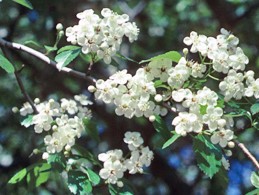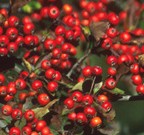 This medium-sized native tree of central and southeastern United States provides interest in spring, fall and winter. In early spring two inch wide clusters of small white flowers make a showy display and are followed by simple dark green leaves that turn purplish red in the fall. The fruits also mature in the fall to bright red berries that persist on the tree through winter. The grayish-brown bark exfoliates and reveals an orange layer beneath. The tree can be used as a specimen or pruned into a screen or hedge that is a real barrier because of its one and one half inch thorns. The berries are attractive to the birds, the flowers and leaves to several butterfly adults and larvae, respectively. Although more disease resistant than other hawthorns, it may have problems in this regard.
This medium-sized native tree of central and southeastern United States provides interest in spring, fall and winter. In early spring two inch wide clusters of small white flowers make a showy display and are followed by simple dark green leaves that turn purplish red in the fall. The fruits also mature in the fall to bright red berries that persist on the tree through winter. The grayish-brown bark exfoliates and reveals an orange layer beneath. The tree can be used as a specimen or pruned into a screen or hedge that is a real barrier because of its one and one half inch thorns. The berries are attractive to the birds, the flowers and leaves to several butterfly adults and larvae, respectively. Although more disease resistant than other hawthorns, it may have problems in this regard.
Type: Deciduous tree

Form: Vase-shaped
Growth Rate: Slow
Bloom: Two inch wide corymbs of small white flowers in early spring
Size: 20-30’ H x 20-25’ W
Light: Full sun preferred; tolerates some shade
Soil: Average, moist, well-drained
Hardiness: Zones 5-8
Pests and Diseases: Susceptible to cedar hawthorn rust, fireblight, fungal leaf spots, powdery mildew, cankers, apple scab, borers, caterpillars, lacebugs, leafminers and scale.
Propagation: Cuttings
Outstanding Selection: ‘Winter King’ (more disease resistant, more flowers, larger fruits).
